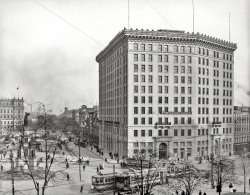
MAY CONTAIN NUTS

Search Shorpy
SHORPY ART

Framed or unframed, desk size to sofa size, printed by us in Arizona and Alabama since 2007. Explore now.
Join and Share
Ad-Free Shorpy
Shorpy is funded by you. Patreon contributors get an ad-free experience.
Learn more.

Recent comments
- Lofty addition
- In 1912
- Keenan Building
- Six years old
- Taken from the P.J. McArdle Roadway?
- It stood only 47 years
- Three track mind
- Incline to the right
- Reach for the sky, 1912 style
- No clean sweep
- Same Job Title, Same Face
- Sadly Lost
- Beautiful ...
- Where you get your kicks
- Aim High
- Pueblo Revival sisters
- Pueblo Neoclassicism
- Milk Man
- Regional dialect.
- Spielberg's inspiration
- Great Photo
- Loaf Story
- Do you still have the Rakes category?
- Could almost be a scene from the 1957 movie 'Hell Drivers'
- The Wages of Fear.
- Conspicuous by their absence
- Got Milk?
- All that aluminum
- No lefties
- Smoke 'em if you've got 'em
Member Photos
The Shorpy
Print Emporium
Print Emporium
Search Shorpy
Search results -- 30 results per page
- Hotel Pontchartrain: 1907
- The Hotel Pontchartrain in Detroit circa 1907. By the mid-teens the hotel had been topped off with a huge mansard roof that added five floors ... Posted by Dave - 08/20/2012 - 9:54am -
![Hotel Pontchartrain: 1907 The Hotel Pontchartrain in Detroit circa 1907. By the mid-teens the hotel had been topped off with a huge mansard roof that added five floors of guest rooms. Detroit Publishing Company glass negative. View full size.
And Of Course ....it was torn down in the 1960's, right? There's a Burger King on that corner now, right?
Near MissBottom left corner, near the photo label. Looks like a man might get a chance to try out the pedestrian catcher on the front of the street car, if he doesn't scoot out of the way pretty quickly.
I love the way everyone is "dressed up" back in those days.
The PontchThe Hotel Pontchartrain stood on the southeast corner of Woodward Ave. (foreground) and Cadillac Square (along left side of the Hotel). According to the book "Detroit Then and Now," the Russell Hotel stood on this site from 1857 until it was torn down to make way for the Hotel Pontchartrain, which opened in 1907. In 1920, the Hotel Pontchartrain was demolished to make way for the National Bank Building at 660 Woodward Ave. It is now known as the First National Building (shown below).
View Larger Map
Short LifeIt only lasted 13 years??
Built by George DeWittBuilt by George DeWitt Mason, it was torn down in 1920. His architectural partnership was also responsible for many other Michigan landmarks, among them the famous Grand Hotel on Mackinac Island. Albert Kahn apprenticed with Mason's firm, and later went on to design many of Henry Ford's auto plants. The current Pontchartrain Hotel is in a different location close to the Detroit River.
Build, demolish, replace. Repeat.Why was this substantial-looking building torn down after only 13 years? I thought that kind of wastefulness only happened in modern-day Las Vegas.
MisfitI got curious about the sign MISFIT, and since it is next door to a billiards parlor thought it might be a sleazy bar or something. A Google search turned up this article from 1889.
Seems as though Shorpy should know about that shop!
[This particular Misfit was the haberdashery owned by Sol Berman at 120 Woodward Avenue. There's another Misfit sign shown here, in New York, and here, in St. Louis. - Dave]
HugeIt makes me dizzy looking at this now, being used to seeing tall buildings, but that was 1907! It would have been even more amazing then.
The PontchMuch of the block south of the old Pontch (the Metropole in particular) is still standing, in various stages of use and upkeep.
A Short StayA big reason the "Pontch" didn't last that long is that only a few of the rooms had private baths. When it opened in 1907 most high-end hotels still used shared baths.
When the Detroit Statler was completed in 1916 all 1000 rooms all had private baths and central air-conditioning, the first hotel in the country to do so.
Seven US presidents visited its famous long bar.
The picture here is prior to the addition of the top five floors in 1916.
[I think it was the Statler's public rooms that were air conditioned, sometime in the 1930s. - Dave]
StreetcarsI notice that most of the streetcars seem to have been able to operate in only one direction so I suppose they had reverse loops at the end of the track or else they made complete loops through downtown. In one of the Pontchartrain Hotel photos there is a Birney(?) car with the ability to swap ends with the trolley pole for bidirectional operation.
TrolleysI sort of remember the old Webster/Melrose Avenue trolley cars in the Bronx. They had driver controls at either end. At the terminus, 149th Street, the driver then pushed the seatbacks forward (or backward) so that the passengers could sit facing the direction of travel. The conductor then took his operating lever and went to the opposite end of the car, folded his seat down and took control. I also think he reversed something on top of the car, probably the rods that connected to the overhead power lines. During the warmer months the sides of the car were open.
The Flamingo Roomat the Hotel Pontchartrain, from a color post card mailed in Detroit at 4 pm on July 24, 1909. The publisher? Detroit Publishing Company, of course!
(The Gallery, Detroit Photos, DPC, Streetcars)](https://www.shorpy.com/files/images/4a22512u.thumbnail.jpg)
- Turkish Trophies: 1910
- ... Elks Monument and Wayne County Building." Far right, the Hotel Pontchartrain. 8x10 glass negative. View full size.
Ferry tales Wow! ... Posted by Dave - 12/02/2022 - 5:58pm -
![Turkish Trophies: 1910 Detroit circa 1910. "Campus Martius -- Soldiers' and Sailors' Monument, Elks Monument and Wayne County Building." Far right, the Hotel Pontchartrain. 8x10 glass negative. View full size.
Ferry talesWow! - wethinks - wouldn't it be swell if the truly ginormous D.M. Ferry warehouse was still around ?? Well we're (sort of) in luck: it (sort of) is.
The "sort of" part being, sadly, that the westernmost building in the complex (above) - the back of which we see in the main picture, isn't the part that's still around.
Oh deerI can find the Soldiers and Sailors monument on googmaps, but looks like the arch thing with Bambi's mom and dad on top is no longer with us?
Comparing 1910 to 2022, seems like I always prefer the old to the new. So much more lively and real.
Dyslexia Hotel Usually Shorpy hotels burn. But here, we have the Burns Hotel.
Hello, Dolly?This looks a lot like the still photo that opens the film version of Hello, Dolly. Is it?
[That was New York on a Hollywood backlot -- a still that morphs into live action. - Dave]
Interurban StreetcarAt the bottom right is an interurban streetcar that would have travelled to any number of Michigan locations, and even Toledo, Ohio. The interurban system was extensive, covering over 500 miles of track. This car looked quite deluxe compared to the city cars -- in railway car style, it even has an open rear platform.
Hotel PontchartrainThere are better photographs of the Hotel Pontchartrain. But I'm taking this opportunity to share what I found.
There was a good article with photographs in the January 1908 Architects' and Builders' Magazine, when the Pontchartrain was new. The architect, George D. Mason described the mechanics, features, and decor of the hotel. He wrote the hotel was designed anticipating four stories might be added later. In April 1908, an ad said rates were $2 per day and up.
In 1913 five stories were added, and a review in The Architectural Review included exterior and interior photographs, plus floor plans. Here is the basement.
Arch RivalThe arch was a temporary build celebrating the 1910 convention of the Benevolent and Protective Order of Elks. The inscription is the Elks' motto: "The fault of our brothers we write upon the sand. Their virtues upon tablets of love and memory." There was another, larger arch at the other end of downtown; the Elks must have brought a lot of business.
Rajah CoffeeOkay, let’s do the math: 23 cents per pound, or two and a quarter pounds for 50 cents, which is 22.22 cents per pound. Which is such a bargain?
You've got a long way to go yet babyAlthough it would be another 19 years or so before the Edward Bernays ‘Torches of Freedom’ campaign kicked in, it appears as if some of the tobacco companies had already taken such initiatives as early as 1910, if not earlier. True, the Turkish Trophies cigarette billboard does not show the woman actually smoking, but in my mind the connection is clear.
(Panoramas, Cars, Trucks, Buses, Detroit Photos, DPC, Streetcars)](https://www.shorpy.com/files/images/SHORPY-4a25865a2.thumbnail.jpg)
- The Pontch Again: 1912
- Detroit, Michigan, circa 1912. "Hotel Pontchartrain." Yet another view of this relatively short-lived hostelry on ... regulations yet. Check out the street in front of the hotel.
Nice Cleanup Dave I downloaded the original image from the LOC a ... Posted by Dave - 11/08/2023 - 5:20pm -
![The Pontch Again: 1912 Detroit, Michigan, circa 1912. "Hotel Pontchartrain." Yet another view of this relatively short-lived hostelry on Woodward Avenue, whose downfall was a paucity of private bathrooms. Familiar landmarks include the Soldiers' and Sailors' Monument, Cadillac Square and the Cadillac Chair. 8x10 inch glass negative, Detroit Publishing Company. View full size.
"Misfit"I wonder what went down at "MISFIT"? Or did they just sell irregular clothing? And what could those fellas on the corner be taking a gander at?
[Misfit was the haberdashery owned by Sol Berman at 120 Woodward Avenue. The headline below is like something out of the Onion. - Dave]
Anywhere you wantThere do not seem to be much in the way of parking regulations yet. Check out the street in front of the hotel.
Nice Cleanup DaveI downloaded the original image from the LOC a while back. You've done a very nice cleanup job for the Shorpy site! Thank you.
[Thanks, but I didn't do any "cleaning up." - Dave]
My mistake. I'm confusing this image with a sister image you've previously posted that was pretty distressed.
Cheep lodgingsHenry Ford had a purple martin bird house at his home Fairlane that he called the Hotel Pontchartrain. Don't know if Albert Kahn was the architect.
You'd Almost ThinkApparently, the plethora of windows was no offset for the paucity of bathrooms.
Street sightingOdd load waiting to cross the street. Coil of rope? Life preserver? Spare tire?
Aha! Much clearer in closeup. The fellow is obviously hefting a coil of rope headed for a nearby ship chandlery.
(The Gallery, Detroit Photos, DPC, Streetcars)](https://www.shorpy.com/files/images/4a19783a.thumbnail.jpg)
- Watering Hole: 1907
- ... interest in this corner of the Campus Martius include the Hotel Pontchartrain, Bagley Fountain and Sol Berman's "Misfit" haberdashery. 8x10 ... Posted by Dave - 05/16/2024 - 5:01pm -
![Watering Hole: 1907 Detroit circa 1907. "A glimpse of Woodward Avenue from City Hall." Points of interest in this corner of the Campus Martius include the Hotel Pontchartrain, Bagley Fountain and Sol Berman's "Misfit" haberdashery. 8x10 inch glass negative, Detroit Publishing Co. View full size.
TodayHere's roughly the same view today, from the street.
Misfit?Hopefully that's not a clothing store.
[It is a clothing store. -tterrace]
(The Gallery, Detroit Photos, Stores & Markets, Streetcars)](https://www.shorpy.com/files/images/SHORPY_4a18237a.thumbnail.jpg)
- Detroit: 1910
- Detroit, Michigan, circa 1910. "Hotel Pontchartrain and Campus Martius." Frequent photographic subjects of the ... It must have been a challenge trying to operate the tiny Hotel Metropole in the shadow of the giant Pontchartrain.
And what a ... Posted by Dave - 12/02/2022 - 1:05pm -
![Detroit: 1910 Detroit, Michigan, circa 1910. "Hotel Pontchartrain and Campus Martius." Frequent photographic subjects of the Detroit Publishing Co. View full size.
Big BrotherIt must have been a challenge trying to operate the tiny Hotel Metropole in the shadow of the giant Pontchartrain.
And what a testament to the brand power of Coca-Cola. Ninety-five years later, that logo is so modern that it sticks out like a photobomb.
Times They Are A-ChangingIf you were to have taken this picture 5 years before the horses would outnumber the cars.
Who's Selling What??Love to know what "Misfit" is advertising.
["Misfit" seems to have been the retail category for what we would today call clothing seconds, or maybe something more like Big & Tall. There's another Misfit sign shown here, in New York, and here, in St. Louis. - Dave]
WildlifeI love the stag and deer statues. Those things are huge!
Misfits explainedBelieve it or not, people would have their pictures taken and not show up for the prints. Photogs would sell the orphan or - Misfits - pictures to recoup their losses.
The main market for these Misfts, were immigrant bachelors who wanted to send pictures of their sweeties back home, but they either didn't have sweeties, or they didn't have enough to have their pictures taken.
Hence, an immigrant bachelor who wanted to impress the family back in County Cork, or Berlin, would finger through the Misfit bins and pick out athe girl of their dreams.
[That's a colorful explanation but, as noted below, these are clothing stores. This particular Misfit was the haberdashery owned by Sol Berman (you can see BERMAN on the awning) at 120 Woodward Avenue in Detroit. Below, another Misfit Clothing Parlor in New York. - Dave]
Migrating Wildlife The "stag and deer" statue is actually of elk. It's one of several temporary monuments that were erected in Detroit for the 1910 national convention of the Benevolent and Protective Order of Elks (BPOE), which was hosted by the Pontchartrain Hotel.
(The Gallery, Detroit Photos, DPC, Streetcars)](https://www.shorpy.com/files/images/4a25864a.thumbnail.jpg)
- The Pontch: 1910
- The Hotel Pontchartrain in Detroit, seen earlier today around 1907 in this post . Now ... Detroit, Seattle, Pearl Harbor My father worked at this hotel. Detroit was at one time a beautiful city, a safe place to go downtown ... Posted by Dave - 09/11/2011 - 9:42pm -
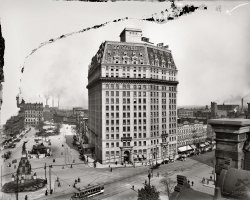
- First National: 1921
- ... The building that replaced the enormous but short-lived Hotel Pontchartrain , a favorite subject of the Detroit Publishing Co. along with ... Posted by Dave - 05/19/2017 - 3:44pm -
![First National: 1921 Detroit, Michigan, circa 1921. "First National Bank." The building that replaced the enormous but short-lived Hotel Pontchartrain, a favorite subject of the Detroit Publishing Co. along with the Soldiers and Sailors Monument, another landmark seen here in the vicinity of Cadillac Square and the Campus Martius. Note the traffic control tower and the tally board labeled DETROIT STREET TRAFFIC KILLINGS. 8x10 inch dry plate glass negative. View full size.
Traffic deathsIt's no wonder so many people are killed. That intersection is nuts!
Almost DoneYou can move right in just as soon as we finish putting up those fancy little doodads on the roof!
The building is still there, but, sadly, the doodads are gone. And you can hardly see the Soldiers' and Sailors' Monument anymore for all the shrubbery and new age beautification in the square. Municipal lipstick, I s'pose.
Impressive LobbyThe architecture firm for which I used to work was planning to occupy the second and third floors (the tall windows with the colonnade). The original bank lobby was in this space and was a beauty: marble columns, gold leaf ornamentation, huge chandeliers and such; you definitely got the feeling that this was an institution to be reckoned with. Sadly, in 1974 they gutted the entire space and divided it with a floor, the better to have more space to lease. When our firm made plans to move in, all the modernizations were removed to reveal some interesting features: the original vault, intact original elevator annunciators, original doors that were walled off for decades and a few surviving ornamentations. Our firm created plans to preserve as much as possible while still having an ultramodern feel; sadly we were not able to go through with the lease at that time.
The intersection is now replaced by Campus Martius Park. Still not any safer, though.
Sandwich anyone?Can anyone make out the sandwich board on the sidewalk in the lower left?
[Left? - Dave]
Sorry, I must've been looking in the mirror.
The GayetyI am always loving all the extra research everybody does on the monuments, people, and locations in the pictures, so here's something I found about the large burlesque theater in the background.
The Gayety, designed by Fuller Claflin, seated 1,362 and opened Sept. 15, 1912. For the theater's entire career, it held burlesque. It was once operated by Frank Bryan and Frank Engel.
The Gayety closed April 10, 1958, and was demolished soon thereafter. Today, a parking lot resides on the property. More pictures here.
[And another view here. - Dave]
Doodadsbryharm's comment sent me questing for technical verbiage of the architectural kind. What we have along the edge of the roof, unfinished, could be described as a cresting of finials. Guarding their young.
Sandwich BoardI think you meant: "the sandwich board on the lower RIGHT."
Looks like an ad for something. Can we get any closer Dave?
[It says "Where Marines T____" - Dave]
Drink Alle____ in Green BottlesCan anyone identify the tasty drink that "hits the spot," that was advertised on the partially-obscured roof sign between the bank and the Gayety theatre? (It's in the same spot that a baking powder was advertised in the 1918 photo of the Pontch.) Since Michigan had in theory been dry since 1918, and the sign wasn't up before 1918, it wouldn't be a brand of beer or other booze. It seems to start with the letters "Alle," so it's not Vernor's.
Architectural ThingamabobI'd call that a cornice. Acanthus leaf motif.
In the name of all humanityI think it's useful to keep a tally of traffic deaths, but cheese Louise, did they have to hang the most recent body right there on the sign? I wonder if his dear mournful widow found a ticket stub to the Gayety in his overcoat.
BrewskiThat sign may be for Altes Lager Bier from Detroit's Tivoli Brewing Company. It came in green bottles.
[You are correct. Below is a detail from a circa 1918 photo of the Hotel Pontchartrain showing an Altes Lager sign that was across the square from the where the other sign would be a few years later. - Dave]
Green bottled beerIt's Altes Lager (German for "old lager"). You can just see the crossed "t" in the sign. Altes (motto: "Tastes like Fassbier") was a old Detroit brewery that passed the Altes brand to various successors. I picked up a case circa 1982. Here's a label, whose lettering looks quite similar to the sign.
[Thanks to you and Alex for solving that mystery. Evidently one of the breweries that survived Prohibition. - Dave]
Acanthus leaf, huh?I bet you're both right, but I liked the "Cresting of finials guarding their young" better! Thanks tterrace.
(The Gallery, Detroit Photos, DPC, Streetcars)](https://www.shorpy.com/files/images/4a25745a.thumbnail.jpg)
- Russell House: 1900
- ... and Cadillac Square." Razed in 1905 to make way for the Hotel Pontchartrain. 8x10 inch dry plate glass negative. View full size.
... Posted by Dave - 01/05/2021 - 4:14pm -
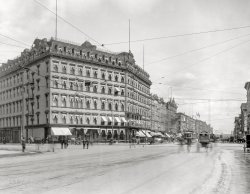
- Cadillac Square: 1916
- Detroit, Michigan, circa 1916. "Hotel Pontchartrain and Cadillac Square from City Hall." Detroit Publishing Co. glass negative. View full size. Earlier views of the hotel: Circa 1907 , minus the upper floors, and 1910 , minus most of the ... Posted by Dave - 12/11/2015 - 4:58pm -
![Cadillac Square: 1916 Detroit, Michigan, circa 1916. "Hotel Pontchartrain and Cadillac Square from City Hall." Detroit Publishing Co. glass negative. View full size. Earlier views of the hotel: Circa 1907, minus the upper floors, and 1910, minus most of the cars.
66?Well, you certainly don't look your age, or something like that.
Kudos on your ranking, though it's hardly high enough -- I tell anyone who has the slightest interest in photography OR history about this site.
Soldiers and Sailors MonumentThe Soldiers and Sailors Monument at left honored those who served in the Civil War. Dedicated in 1871, it sat there until 2004, when it was moved about 100 feet for a street widening project.
In the base of the monument was found a copper box, which was taken to the Detroit Historical Society. It was opened only to find that water had seeped in. All that was found was a bronze medallion and papers (which had the names of all Detroit CW volunteers, according to papers of the day) that had turned to mush.
Bertha Kalich,"leading tragedienne of the Yiddish theater."
http://en.wikipedia.org/wiki/Bertha_Kalich
http://www.imdb.com/name/nm0435747/
Convention CityNote the "Worlds Salesmanship Congress - Automobile Salesmen" going on at the Pontchartrain Hotel that particular week. I wonder if car salesmen were as pushy then as they later became.
Long-gone cityscapeOf all the buildings in this photo only two still stand, the old Wayne County building in the center background and the commercial building next to the Pontchartrain at the far right.
View Larger Map
For a Good Time..Go to Detroit. The Gayety Burlesque and the Old Kentucky Whiskey Co. are almost next door to each other. And if you overshoot the Whiskey Co. on your way from the Burlesque, there's a Bar just past it.
Don't tell the management... I believe we have a coathanger from this hotel hanging in my closet (in Atlanta). I guess I got it from my father, who probably got it with some of his father's clothes when my grandfather died in Pensacola, FL. I think my grandfather spent some of his youth in Michigan, and I've always wondered how, when, and under what circumstances this thing came to be in our hands...
How sad.You'd never see that many people downtown today.
Recent AnniversaryOn July 12, 1909, at the Soldiers & Sailors Monument, a large group of cars began a 2000+ mile trek known as the Glidden Tour. On that same spot, 100 years later, a small group of cars gathered to commemorate the event.
The Glidden Tour, along with the AAA, did much to promote road improvement in America by demonstrating the awful state of roadways of the day.
Hotel What?To the right and behind the Pontchartrain, it looks like "HOTEL ROOKSTOO" What could it be?
["Room $1.00." - Dave]
Asking for itI think I'd be afraid nowadays to ask for something advertised as the "Cock of the Walk."
I was born in Detroit, but was 9 when my family moved us away. This looks like it was a really neat place. At one time.
Does anyone know what the "throne" was for?
Re: The ThroneThe Cadillac Chair, a tribute to Detroit's founder, Antoine de la Mothe Cadillac, was dismantled in the 1940s after it became a popular seating location for "vagrants and drunks."
http://buildingsofdetroit.com/places/chair
There are definitely more than a few buildings in that picture still standing, and the square itself is still somewhat intact.
The PontchThe Pontchartrain to me is the angular-brown-glass '70s building, with its "Top of the Pontch" restaurant, that fascinated the suburban kid I was then on terrifying but exciting field trips or sporting-event trips downtown. Was that a completely different building?
[The Hotel Pontchartrain in this photo was torn down in 1920. - Dave]
Old DetroitI have been told that my father worked at the Hotel Pontchartrain. He died in 1929. In the late 1930s I went to the Gayety once in a while. Left Detroit in 1953. Left Michigan for Seattle in 1980.
Another viewhttp://www.bing.com/maps/default.aspx?v=2&FORM=LMLTCP&cp=r1nq3q82cmv6&st...
TrolleyLook at the two trolleys in the foreground. They are pulling trailers!
A very rare thing in the US-trolley history.
(The Gallery, Cars, Trucks, Buses, Detroit Photos, DPC, Streetcars)](https://www.shorpy.com/files/images/SHORPY-4a24890a.thumbnail.jpg)
- Detroit Skyline: 1918
- ... back of the First National Bank , which replaced the Hotel Pontchartrain (backside is seen in 1918).
Click to embiggen
... Posted by Dave - 05/07/2023 - 2:28pm -
![Detroit Skyline: 1918 Detroit circa 1918. "Sky scrapers from interurban station, Jefferson Avenue at Bates Street." A view last glimpsed here. 8x10 inch glass negative, Detroit Publishing Company. View full size.
Now just faces in the crowdThree of the four buildings marked with red dots were very prominent in the 1918 Detroit skyline (at left), but now are just faces in the crowd. At the bottom with a red dot is the back of the First National Bank, which replaced the Hotel Pontchartrain (backside is seen in 1918).
Click to embiggen
A lot happens in a yearComparing the 1917 view and this 1918 view, two new skyscrapers were built! Is that even possible? The Cadillac Square building at the right (which still exists but lost it's its minarets), and the white building in front of the Hotel Pontchartrain, which is gone. In fact, even this portion of Bates street is gone, it's now under the City-County building and the parking structure behind.
["Circa 1917" doesn't mean "in 1917." It means around ("circa"!) 1917. - Dave]
Number 97What is with the large 97's on the one building corner as well as the water tower?
Hide and seekThe white building half hiding the Hotel Pontchartrain in the original photo is called the Vinton Building. In Doug Floor Plan's photo, it is hidden behind the Z-shaped First National Building. This photo shows the Vinton Building with the First National behind it.
Number TowerThe number "97" on the water tower and building is advertising the street address of the Fred Lawrence Printing Company at 97 Woodward Avenue. Their street sign is visible in both images. The earlier image doesn't show the number.
(The Gallery, Detroit Photos, DPC)](https://www.shorpy.com/files/images/SHORPY-4a55243a.thumbnail.jpg)
- Eureka Vacuum: 1912
- ... Also the block of buildings on the left south of the Pontchartrain Hotel are still standing.
Re What were they thinking? "When this is ... Posted by Dave - 08/04/2021 - 3:43pm -
![Eureka Vacuum: 1912 Detroit, Michigan, circa 1912. "Woodward Avenue." A shopper's paradise. Meet you in an hour at Cinnabon. Detroit Publishing glass negative. View full size.
View from Grand Circus ParkDetroit renumbered all of their street addresses in 1920. Therefore, the old 260 address on the left indicates that this photo was actually taken from Grand Circus Park where Park Ave. (foreground) intersects with Woodward.
View Larger Map
View Larger Map
I am disappointed!!Just when I was in the mood for some Chop Suey and not a place in sight.
Player Pianos, Fifth FloorHope they had a good elevator!
Woodward buildings still standI think the current street view above is a little off. I think this picture was taken from a spot just south of Grand Circus park between where the Whitney Building and Broderick Tower are now. Most of the buildings on the right including Grinnell Brothers still stand. Also the block of buildings on the left south of the Pontchartrain Hotel are still standing.
Re What were they thinking?"When this is 'View full size' we're all be dead."
PianosI counted 6 piano stores not 3.
Grinnell BrothersGrinnell Brothers (sign on right side of street) was a Detroit area institution all the way into the 1980's, when the entire chain went out of business. They had stores in every area mall and not only sold pianos, but other musical instruments, lessons, records, sheet music, pianos rolls, everything to do with music. Wonderful stores, they just couldn't keep up with the times.
What were they thinking?I love pictures like this! This is a frozen second in the lives of all these people. Where were they all going? What were they thinking about? Who was worried, or excited, and about what? Who had just gotten good news, or bad news? Who was going to work, or to do something fun? Who was pregnant, or had new a child, or grandchild?
I also wonder what was playing at the theater. I assume it was live theater, primarily, although there were quite a few short films, and the production of feature-length films was only a few years away.
If I had my choiceI have to agree with user "tterrace", I'd much rather walk down the 1910 version of Woodward than today's, oh if just for a day. What sights to behold.
What happenedGrowing up in Detroit and remembering my mother taking me downtown on the streetcar and shopping at Hudsons, Kerns, and Crowleys and then for being a good kid she took me across the street to Kresge's downstairs and bought me a waffle sandwich which I will never forget. I often hear the phrase "you can't go back" but I miss and loved the way the city was.
Mouse Furs, yuck!Oh wait, it's Mau's Furs.
Never mind.
What Could It Be?I wonder what the three objects are on the street to the left and in front of the second streetcar. No one is near them.
[Newspaper bundles, thrown off the streetcar for pickup by Woodward Avenue newsies, would be my guess. - Dave]
Prettier?I won't get in to the prettier/not prettier debate, but based on Anon. Tipster's Google Street View links, the adjectives that occur to me are more along the lines of : 1910: alive, vibrant, visually diverse, inviting; 2011: sterile, lifeless, visually monotonous, inhospitable.
Hats anyone?As far as I can tell, with the exception of one small boy, everyone is wearing a hat. Ah, those were the days.
Lots of piano storesI counted three different piano shops on this block, Bush & Lane, Manufacturer's and Melville Clark. Was this a sort of "piano district" at the time, or were pianos just ubiquitous enough in parlours of the day that several dealers on a single block was nothing unusual?
[Player pianos were, I think, something like the plasma TVs of their day. - Dave]
"Spirit of Detroit"The buildings at the left have been replaced by the statue "Spirit of Detroit" and Coleman Young Municipal Center. There's an automatic "people mover" tram running almost directly above where the camera was. This part of Detroit is quite a bit prettier now than it was a century ago.
View Larger Map
View Larger Map
Urgent need to tinkleIs there anyplace on this street that sells pianos??
Of course it's DetroitMore cars here than any other 1910 picture we have seen.
One thing, I think I'm pretty knowledgeable about antique cars, but does anyone know what the heck that round tank on the rear of the car at center right is? Has me puzzled.
[Something steamy, perhaps. Condenser? Reservoir? - Dave]
Are You Properly Attired? The boy about to board the trolley seems to be, although the ring around his shoulders could also be a part of whatever he's dragging behind him. A lamp maybe? Hard to tell - I run out of pixels before I can enlarge/enhance it enough. Still, it looks like a bicycle tire to me. Perhaps other Shorpists will have better data.
Bush & Lane Piano Co.on the left had their main manufacturing facility in Holland, MI. They went out of business in 1930, victims of the Depression as were many other piano manufacturers.
Right RulesLooks like all the cars of the time were right hand drive. Anyone know when we decided to change?
[Gradually. - Dave]
Majestic TheatreThe Majestic Theatre opened in April 1915 per its website, so I wonder it that dates this post to 1915.
[Detroit had several Majestic Theatres over the years. The Majestic in this photo opened in 1908 at 231 Woodward. - Dave]
Piano StoresOK, I count at least six piano stores! And at least three fur stores.
More piano storesI'm counting possibly seven piano stores--Bush and Lane Pianos, Manufacturers Piano Co, Cable Piano Co, Tarrand Pianos, Grinnel Bros Pianos, Melville Clark Pianos, and another just to the upper right of the Grinnel Sign. I'm surprised that there isn't a Wurlitzer sign somewhere in this. I'm also seeing a Victor Records. Pianos were all the rage for years--before everyone had radios and tv. People learned to play for entertainment for themselves and others.
(The Gallery, Detroit Photos, DPC, Stores & Markets, Streetcars)](https://www.shorpy.com/files/images/4a24401a.thumbnail.jpg)
- Teeth Without Plates: 1905
- ... the curb about a block down isn't for construction of the Hotel Pontchartrain (if so the picture would seem to date from 1906, as that's when ... Posted by Dave - 03/29/2023 - 1:27pm -
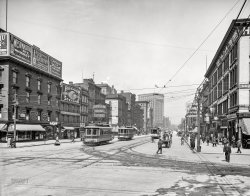
- Detroit Landmarks: 1908
- ... "Cadillac Square, Soldiers' and Sailors' Monument and Hotel Pontchartrain from City Hall." Also the lower section of one of the city's ... Posted by Dave - 05/19/2023 - 12:32am -
![Detroit Landmarks: 1908 Detroit, 1908. "Cadillac Square, Soldiers' and Sailors' Monument and Hotel Pontchartrain from City Hall." Also the lower section of one of the city's famous "moonlight tower" arc lamps. And: Someone stop that hat! 8x10 inch glass negative, Detroit Publishing Company. View full size.
A Spindly AffairThis is my first time to see one of those moonlight arc lamp towers up close. Seems kind of flimsy - though I notice all the guy wires. Climbing one of those for maintenance was surely a risky business and there doesn't seem to be anything to prevent anyone from doing so.
[The lamps probably come down to street level for maintenance. Hence the crank. - Dave]
Moonlight ElevatorDave, the lights didn't travel down to meet the man. The man used a hand-cranked elevator to travel up and service the lights. This is depicted and described in the following NY Times news article:
https://www.nytimes.com/2014/02/16/travel/austins-moon-towers-beyond-daz...
(The Gallery, Detroit Photos, DPC, Streetcars)](https://www.shorpy.com/files/images/SHORPY-4a22856a.thumbnail.jpg)
- Motown Rising: 1918
- ... Square and the Soldiers and Sailors Monument with the Hotel Pontchartrain on the right and the Real Estate Exchange at left. At the Gayety: ... Posted by Dave - 08/02/2012 - 5:23pm -
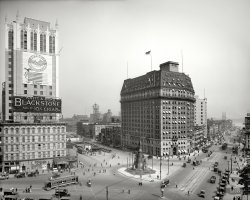
- Moonlight Tower: 1899
- ... Square), then I'm guessing this photo was taken from the Hotel Pontchartrain.
Eight Storeys in the Naked City From Printer's Ink, July ... Posted by Dave - 10/17/2020 - 10:35am -
![Moonlight Tower: 1899 Detroit circa 1899. "Majestic Building." And a good view of one of the "moonlight tower" arc lamp standards whose base can be seen in the previous post. Some of these towers are said to have made their way to Austin, Texas, where they are the sole remaining examples of their kind. View full size.
Public TransportationIt looks like you don't have to wait long for a streetcar.
The lady carries a swordI am intrigued by the statue in the lower right. Does she still stand? And what is her story?
All gone...nearly Corner of Woodward and Michigan Avenue. That's the old city hall at the left side of the photo. As in the previous photo of the old post office, nothing in this photo remains today.
Well, almost. You can see this cannon at the Dossin Great Lakes Museum on Belle Isle, as it was removed there when the city hall was razed in 1960.
Snap, Crackle and Pop!The early carbon arc street lamps were not necessarily as popular an innovation as one might assume. I don't know what Detroit residents thought of theirs, but a similar system was installed in San Diego in 1886, and earned many bitter complaints from the residents. The lamps were too bright for one thing, and people who had grown up with candles and kerosene lantern lights were appalled by the harsh, blue-white arc lights that cast shadows deeper than the noonday sun. The company's solution was to raise the masts to as tall as 125 feet (below, in an 1887 photo), but it scarcely helped. And the heavy carbon rods were exposed to the moist and often foggy night air from the adjacent bay, resulting in an all-night racket of pops and small explosions that kept everyone awake. San Diego's carbon arc lamps lasted only to 1889, when the lighting company failed in a local economic collapse, but their removal was unlamented by the long-suffering residents.
Peninsular ElectricThere's another tower at the next intersection. It must have been successful because I can't see any remains of the gaslights that must have preceded it. The Peninsular Electric Light Company was founded in 1891 to run Detroit's street lights. It seems there were 142 of them (but probably not 142 towers).
Aglow in AustinI live about two miles from one of the "moon towers" in Austin. It's very high up, and shines brightly every night. Of course, there's lots of other light around, so it's hard to tell just how much it's casting. I've often wondered what it would look like if it were the only light source.
Austin memoriesI'd forgotten all about these. I moved to Austin for college 40 years ago and lived near a light tower myself. It wasn't "the only light source," but Austin in those days was a much, much smaller town with far less light pollution than today. The artificial moonlight was noticeable from almost anywhere in town, as I recall.
Check the Plaque DaveLooks like they bought them new in Austin.
[Hello? The plaque doesn't have a thing to say about new or used. There are, however, plenty of references describing how the city of Austin bought 31 used towers from Detroit in 1894. - Dave]
Sword carrying ladyThe lady is on the Soldiers and Sailors Monument, dedicated in 1872 to honor Michigan's Civil War veterans. The monument was moved about 100 feet a few years ago.
RE: circaI know the Library of Congress says circa 1880-1899.
But I think this might be 1902. Because the sale signs say, "A BUSINESS REVOLUTION Change of Ownership-Management".
Which jibes with this, from 1902:
Pardridge & Walsh, dry goods merchants, for many years at the corner of Woodward avenue and Congress street, purchased the immense stock and fixtures of C. A. Shafer in the Majestic building for about $140,000, and continued the management of both stores until the end of the year.
[Finish reading the signs and you'll see that the photo shows C.A. Shafer moving into the building, not out of it. This negative is listed in the 1899 Detroit Publishing catalog. - Dave]
Cadillac SquareIf that's the Soldiers and Sailors Monument in the lower left right (as identified in earlier posts of Cadillac Square), then I'm guessing this photo was taken from the Hotel Pontchartrain.
Eight Storeys in the Naked CityFrom Printer's Ink, July 5, 1899:
"The finest commercial structure in Michigan is the Majestic Building, Detroit, occupied by the department store of C.A. Shafer ... Mr. Shafer uses eight floors and the basement."
In 1901 Shafer was bought out by Pardridge & Blackwell. This photo must date from between 1896, when the building was completed, and 1901, when P & B took over. Also, General William Booth (as advertised on the street banner) did a tour of U.S. cities in 1898.
Appearing at the AuditoriumGeneral William Booth wasn't just any Salvation Army speaker, he founded the organization in 1878, after the 13 years that he and his wife Catherine spent leading his East End (London) organization, The Christian Mission, nee The Christian Revival Society, itself formed after his four unhappy years as a Methodist (they wanted him to take a pastorate, he wanted to travel and evangelize). Initially regarded as a crank, by the time of this photo both William Booth and his Salvation Army were highly regarded.
I am wondering if The Auditorium refers to the Auditorium of the Detroit Museum of Art, which at the turn of the century was criticized for booking "shallow" speakers, not aligned with the "purposes for which the art museum was organized." (see: "Museum on the Verge," by Jeffrey Apt, Wayne State Press, 2001)
1896-1962The Majestic was Detroit's second skyscraper.
Soldiers and Sailors MonumentThe lady in the lower right stands atop the Soldiers and Sailors Monument, which commemorates the civil war. The statue, as mentioned above, was recently moved about 100 feet, to accommodate the re-creation of a park in Campus Martius. Its still there and looks as good as the day she was unveiled. Stop in sometime and have a look. Its at the heart of downtown Detroit.
Demolition of City HallThe corner of old Detroit City Hall is seen at the left edge of the photo. In one of the most notorious incidents in the history of Detroit, as preservationists and boosters alike fought to save the old city hall, an injuction was filed to stop the demolition. The contractor snuck a bulldozer into the site at midnight and demolished the portico on the front of the building, compromising the structural integrity of the edifice, and forcing the full demolition.
Moonlight Towers in AustinThere are indeed remaining moonlight towers here in Austin. Seventeen of them are still in use, retrofitted with incandescent bulbs in, I think the 1950's.
More info here. lick below to enlarge.
So little trafficLots of streetcars. Some commercial drays. A handful of private coaches.
And many pedestrians. Looks something like Moscow would have until the end of the Soviet Union. Plenty of space on those broad boulevards.
Austin TowersSee all 15 Moonlight Towers - http://www.andymattern.com/moonlighttowers/
Majestic DemolitionI was one of the two crane operators that participated in the demolition of the building in 1962. We hoisted a small 10 ton Bantam crane and a small John Deere loader-dozer atop the building and slowly worked our way to the third floor where the building was becoming unstable. We removed the equipment and finished the demolition from the ground. I worked for Arrow Wrecking Co. for nearly 20 years and am now retired to Upper Michigan. The photos of the demolition brought back many fond memories of my old home town. Thanks.
I wonderWho can read THIS from the street.
Not all goneRDown3657 stated that everything in this photograph is gone. There are at least two buildings on Merchant Row that are still standing. The Vapley Building (look for Vapley Brother Shoes in the photograph) is currently being renovated into loft apartments, and the building immediately south with the arched windows (I do know know of a name for it- it is at 1401 Woodward at the corner of Grand River. There may be others still standing, but those are the only two I can identify with 100% certainty. And, of course, the Soldiers and Sailors statue still remains.
(Technology, The Gallery, Detroit Photos, DPC, Streetcars)](https://www.shorpy.com/files/images/4a03649a.thumbnail.jpg)
- The Heart of Detroit: 1907
- ... Sailors' Monument, Cadillac Square, Wayne County Building, Hotel Pontchartrain. Panorama of three 8x10 glass negatives. View full size.
... Posted by Dave - 08/29/2012 - 10:13am -
![The Heart of Detroit: 1907 Detroit circa 1907. "The Campus Martius." Landmarks include the Detroit Opera House, Soldiers' and Sailors' Monument, Cadillac Square, Wayne County Building, Hotel Pontchartrain. Panorama of three 8x10 glass negatives. View full size.
A calamity?Something big must be going on behind the Pontchartrain! A fire engine speeding left to right and dozens of men appear to be running toward the same destination. Or is it happy hour at the establishment proclaiming Kentucky Whiskey available here? Even the group of folks standing at the corner of the Hotel have their attention turned in that direction! So much going on here!
High speed photographyNo Shorpy spirits, except the sprinters already mentioned.
Concerning those lights, how much illumination did they actually cast?
Is a radio towerin the center of the picture? It appears to be a large tower.
[It's a street light. -Dave]
Horse SenseThe Motor City with more horses than motors! In back, the classic sign of economic progress -- smokin' chimneys.
Rajah CoffeeCan Starbucks be far behind?
SeedyJust sayin'
Moonlight TowerI believe that the structure in the center foreground of the photo is a moonlight tower. It was an early form of street lighting where there would be one tall tower with bright, probably carbon-arc, lights instead of multiple smaller lights closer to the ground. Austin, Texas is the only city that still has these in operation, although they have been updated to use a modern light source.
[A Shorpy favorite, seen in many of our Detroit photos, for example, here, here and here.]
re: SeedyThe Ferry Seed Warehouse seen in the background is at the western end of what is now Greektown. It's now an office building.
Women downtownI have noticed over and over on Shorpy that almost every city street scene in the northern states features women bustling about, presumably doing their shopping, having lunch with their friends, walking with their daughters, etc. In the photos of southern cities, you almost never see women on the streets. Nearly every southern city street scene comprises pretty much entirely men. Why is this? Heat? No place for "a lady" to be seen? Has anyone else noticed this?
"Man of the Hour," againAlso playing on Shorpy at https://www.shorpy.com/node/11486
The NYT called it a "Virile Melodrama," and said: "A youthful Mayor who cannot be bribed or intimidated, a financier who wants to get control of a street railway franchise in perpetuity, and a pair of political bosses, who are at odds with each other and who are fighting to gain supremacy in their organization -- these are the chief characters in George Broadhurst's play "The Man of the Hour.""
D.M. Ferry and U of Michigan sportsDexter M. Ferry, the man behind the seed company in this picture, donated the land in south Ann Arbor on which today's U of M athletic venues stand. One of which, the outdoor track and field venue, is named Ferry Field. Before today's Michigan Stadium, Ferry Field was the home of the football Wolverines, and the iron gate with the "FERRY FIELD" name remains in place on south State Street.
True CrimeAnother fantastic pic of the Campus Martius area, giving the rare view up Monroe Street where Gies's European Hotel operated (the attached building to the left of the Hotel Fowler, center of pic). In 1894, the infamous H. H. Holmes lodged Mrs. Pitezel there for a few days, the poor woman never knowing her daughters Alice and Nellie were but five blocks away.
(Panoramas, Detroit Photos, DPC, Streetcars)](https://www.shorpy.com/files/images/SHORPY_Detroit_Panorama_1.thumbnail.jpg)
- Bustling Detroit: 1915
- ... in this panorama of two 8x10 glass negatives are the Hotel Pontchartrain, Soldiers' & Sailors' Monument, Ford Building, Detroit City ... Posted by Dave - 07/28/2012 - 4:11pm -
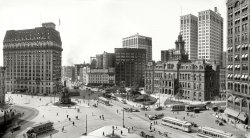
- New Denechaud: 1908
- New Orleans circa 1908. "New Hotel Denechaud, Poydras Street." A century later, it's the hotel Le Pavillon. Detroit Publishing glass negative. View full size.
... south Louisiana. Mollusk shells dredged from brackish Lake Pontchartrain were used as gravel throughout the area until quite recently. ... Posted by Dave - 08/05/2012 - 4:24pm -
![New Denechaud: 1908 New Orleans circa 1908. "New Hotel Denechaud, Poydras Street." A century later, it's the hotel Le Pavillon. Detroit Publishing glass negative. View full size.
Le PavillonMy wife and I stayed there several years ago, and we had dinner there just a few weeks ago. The dining room is on the ground floor in the corner nearest the camera.
It's a very nice hotel with a unique touch. Every night at 11, they serve to the guests peanut butter sandwiches on silver trays, and hot chocolate from silver urns.
But the people who work there apparently can't pronounce the name of the hotel with proper French diction.
Creole, not CajunNew Orleans is not a "cajun" city. It is creole at best, and if anything most street names aren't pronounced correctly either.
French diction?This isn't Paris -- it's Nawlins!
CoverageAre those sea shells on the roof in the foreground? I believe most modern roofs use stones. Interesting.
Very beautiful building! I can imagine how impressive it was at the time!
Roof GardenIs that a little ivy garden boxes on the roof of the building in the corner? Sure looks it!
[Horticulture a la Morticia Addams. - Dave]
LouisianaWe dont speak French here. We speak Cajun, a 200 year old corruption of French, so don't expect proper French pronunciation.
Early Sunday morningGiven the long shadows for the low sun and the orientation of Carroll Street, and the absence of anyone except the lone blurred horse and cart (deliveries), sure looks like an early Sunday shot to me. Real nice photo too!
[Also note the shadowy figure in the alleyway. - Dave]
Denechaud / DeSoto / Le PavillonIn between its opening as the Denechaud and the current name of Le Pavillon, for generations the hotel was known as the DeSoto. I recall when the question of correct pronunciation of "Le Pavillon" came up, a local old timer piped in "De Soda."
The text on the back of the attached early 20th century postcard view of the lobby reads "$1,000,000.00 Hotel DE SOTO New Orleans. The ONLY ABSOLUTELY FIREPROOF HOTEL IN NEW ORLEANS. ALL OUTSIDE ROOMS. Famous for its Creole Cuisine. Rates $1.00 and Upwards."
The lobby is still one of the most beautiful in the city. I believe the rates have gone up.
Lots of charmLovely building! The chimney is blowing off quite some smoke - must have been a windy day!? Le Pavillon still looks charming today and, I just found out, seems to be famous for the occasional ghost apparition.
Max Barnett Furniture Co.Max Barnett Furniture Co. can be seen in the background. It was established there on Poydras St. in 1899, and was located there until they moved in 1928.
Smokestacks still thereThe two smokestacks are coal burning stacks, which were used for producing electricity until 1973. They are located in the 1200 block of South Peters Street. Maybe someone else can help identify the other tower, as it was prominent in the New Orleans skyline until a few years ago.
Yes, shells on roofThere are no stones in south Louisiana. Mollusk shells dredged from brackish Lake Pontchartrain were used as gravel throughout the area until quite recently. Dredging in the Lake was banned in 1990 to reduce the turbidity and stirred-up pollution. The lake is now clean enough for swimming much of the time. I've also seen oyster shells used for gravel in NOLA.
(The Gallery, DPC, New Orleans)](https://www.shorpy.com/files/images/4a23119a.thumbnail.jpg)
- Cityscape: 1917
- ... roof of interurban station." Landmarks here include the Hotel Pontchartrain, Ford Building and Dime Savings Bank. 8x10 inch glass negative, ... Posted by Dave - 08/15/2012 - 4:14pm -
![Cityscape: 1917 Detroit circa 1917. "Looking northwest from roof of interurban station." Landmarks here include the Hotel Pontchartrain, Ford Building and Dime Savings Bank. 8x10 inch glass negative, Detroit Publishing Co. View full size.
Sans PeerThe Peerless Film Company, shown in the foreground, was a film distribution firm. Detroit was home to a dozen or more of these concerns. The old nitrate films were highly unstable and it was not uncommon for them to spontaneously burst into flames. That is why the distribution companies eventually built a single building to house their products. The Film Exchange Building still stands on the northern edge of downtown, and yes, it is built to withstand fires.
By the way, the Peerless address was 153 East Jefferson, placing it just where the current CAY building stands. That side street with the tailgated horse cart, is Bates.
Come across the RiverI just noticed the sign for the Windsor Races (just under the Lawrence Printing Company). If this is 1917 that probably makes it the late spring or summer which means that Detroit (and America) are finally in a war that the Canadians in Windsor have been fighting for three years. And if then is anything like today they'll be featuring harness racing while on the north side of the river (Detroit) they were running thoroughbreds, if they were running anything at all. In years past - and maybe this year - there might have been recruiting stations at or near the races, and if they got the occasional American that was fine with them. In 1917, with Americans being drafted and Canada about to impose conscription, I doubt that would be happening much.
Which is the Ford building?The hotel has a sign to identify it; thus I am assuming the other two skyscrapers are the bank and the Ford building (perhaps the one on the left?). In any event, I am surprised at the size of the building. To have such a building to house office workers, already built and in-use by 1917, when Ford had introduced the Model T only 9 years earlier, makes me wonder how many workers it took to manage the paperwork. Did Ford have more clerks than autoworkers?
[The Ford Building (also seen here) was built by the family that owned Edward Ford Plate Glass and had nothing to do with Ford cars or Ford Motor Co. - Dave]
[This is exactly why I will never qualify for Jeopardy! But who knew that Detroit had another industrialist named Ford?]
Clean roofsAs someone who spends a great deal of time on flat commercial roofs, it always amazes me how empty such roofs were in the era before air conditioning and wireless communications. And the chimney at the far left (next door to Peerless Film) is long overdue for re-pointing.
More landmarksThe Penobscot (now Annex), Hammond, Majestic, City Hall are all visible here.
It's interesting to see the Pontchartrain from an angle that doesn't just show the Woodward facade.
There appears to be a very impatient motorist tailgating a horse-drawn cart in the lower right. An early road hog.
(The Gallery, Detroit Photos, DPC)](https://www.shorpy.com/files/images/4a24889a.thumbnail.jpg)
- The Motor City: 1917
- ... Shorpy landmarks here include the Wayne County Building, Hotel Pontchartrain, Ford Building, Dime Bank and Detroit Post Office. View full ... Posted by Dave - 08/08/2012 - 7:36pm -
![The Motor City: 1917 Circa 1917. "Detroit looking southeast along Woodward Avenue from the Whitney Building." Shorpy landmarks here include the Wayne County Building, Hotel Pontchartrain, Ford Building, Dime Bank and Detroit Post Office. View full size.
Hotel GriswoldThe hotel opened in 1910 on the corner of Griswold and Grand River Ave. It is where the Kiwanis Club was founded in 1914.
It has since been torn down and a parking garage now sits on the old site. Yet another beautiful building lost to time.
This picture gets me steamedThe "smokestacks" on the far left are actually vents or pipes for steam, apparently for an underground steam exchange station for the City of Detroit (which provides steam heat and electricity from a central plant for city owned properties, such as the nearby Farmer Branch of the Detroit Public Library). In the early 1990's I worked in Downtown Detroit, and the building at 1413 Farmer St. was still there, but was soon demolished and replaced by a single steam vent pipe. I believe the stacks just went THROUGH the building, and were not a part of it.
Rayl'sThe store that was once the Walmart of Detroit. Very interesting story on the company and the building can be seen here.
If it were a snakePerhaps it is too obvious, but most Detroiters, I dare say, would think it was remiss of you not to mention Hudson's as a landmark of this view.
[It is indeed a landmark although, not being a subject of previous posts here, not really a "Shorpy landmark." - Dave]
Tip o' the HatNow I see where those ubiquitous white hats in Shorpy photos come from. Detroit! Looking through the windows of the white building (down front center) you can see scads of them and possibly hat boxes as well.
And here I thought they came from Panama!
Hudsons Grows ( and Falters ) with DetroitWow! What an interesting and sad tagline! How prophetic! Although it has been sold to NY Macy's...JL Hudson's is just one of many stores that flourished when Detroit was at in heyday. Thank you for this photo! How I wish my dad were alive to share his own personal memories of these famous landmarks.
(The Gallery, Cars, Trucks, Buses, Detroit Photos, DPC, Streetcars)](https://www.shorpy.com/files/images/4a25671a.thumbnail.jpg)
- Cadillac Square: 1902
- ... old hotels, the Russell House, first opened in 1857. The hotel has since been replaced with two successive buildings, each bigger than the last. First came the Hotel Pontchartrain (a great favorite of both the Detroit Publishing Co. and the ... Posted by Dave - 02/13/2013 - 12:14pm -
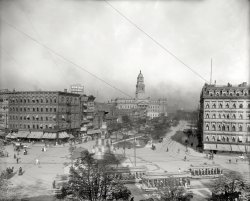
- Rooms With a View: 1912
- Detroit, Michigan, circa 1912. "Hotel Pontchartrain, Soldiers' and Sailors' Monument." Along with the Flatiron ... find a thing about it! The only things I find are about a hotel in New Orleans, and one in Detroit which was built in the 1920s. I'm ... Posted by Dave - 07/29/2012 - 6:09pm -
![Rooms With a View: 1912 Detroit, Michigan, circa 1912. "Hotel Pontchartrain, Soldiers' and Sailors' Monument." Along with the Flatiron building in New York, "The Pontch" was one of Detroit Publishing's favorite architectural subjects. View full size.
ShadesWhy the selective positioning of window shades on some windows and not others? More permanent residents or offices?
Given a choiceI think I would rather stay at the Metropole where all the windows have awnings.
Is this building still there?I've looked and can't find a thing about it! The only things I find are about a hotel in New Orleans, and one in Detroit which was built in the 1920s. I'm afraid this elegant structure is another of those that 20th century American mod freaks have destroyed. One of the things I loved best about Europe is that they rarely demolish anything. They build everything extremely well and then just keep using it. There are buildings that were there many years before Columbus that are still in use today. The insides are remodeled, but the exterior stays the same. When we were there, in the 80s, there was a lot of scrubbing of old buildings going on, to remove soot buildup from centuries of heating with coal. They came out as good as new! I don't know why we can't do that here!
[This short-lived hotel, whose main deficiency was a dearth of private bathrooms, was demolished in 1920 and replaced by a bank. Its history can be traced right here on Shorpy, in both the photo captions and the comments. - Dave]
(The Gallery, Detroit Photos, DPC)](https://www.shorpy.com/files/images/4a19784a.thumbnail.jpg)
- American Acropolis: 1918
- ... Estate Exchange , Soldiers' and Sailors' Monument , Hotel Pontchartrain , Wayne County Building , Cadillac Square and the ... Posted by Dave - 11/15/2014 - 12:56pm -
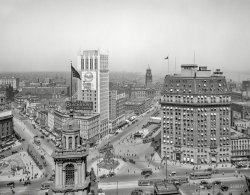
- Temple of Beauty: 1908
- ... the east side of Woodward. In the distance is the original Pontchartrain Hotel.
AG Spalding! Those merchants vying for your trade also includes ... Posted by Dave - 02/23/2017 - 11:03pm -
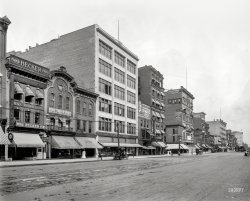
- What Goes Up: 1907
- Detroit, 1907. "Hotel Pontchartrain under construction." The 10-story, 298-room "Pontch," after ... The Pontch was built just before several changes to the hotel industry - bathrooms for each hotel room, early air conditioning, etc. ... Posted by Dave - 03/31/2017 - 12:20pm -
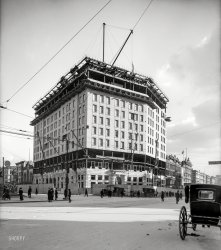
- The Public Square: 1907
- ... "Cadillac Square -- Soldiers' and Sailors' Monument and Hotel Pontchartrain." Two perennial Detroit Publishing favorites. View full size. ... Posted by Dave - 05/19/2017 - 5:09pm -
